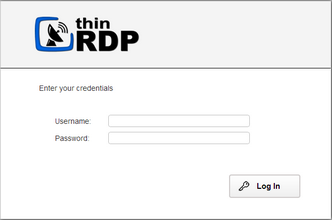This C# asp.net demo is intended to help you learn how to securely authenticate against ThinRDP Server from an external application.
The demo Logon.aspx page is an authentication form that looks identical to the ThinRDP one. This page was designed to exemplify how to authenticate to ThinRDP externally using username/password or apikey and having the authentication data encrypted through the Diffie Hellman Key Exchange method.
After authentication against ThinRDP, the application redirects to the Default.aspx page that has an IFrame pointing to ThinRDP index.html page.

Download this demo here.
The website demo is accessible from the Users documents folder, under the directory \ThinRDP Demos\IISAuth
In order to compile this application, you can use the Microsoft Visual C# Studio 2010 Express.
Open the application from the menu File-Open Web Site.
The web.config parameters:
username/apikey:
The external authentication is set to use username/password by default, but you can also change the web.config file to start using the username/apikey.
Once you set the corresponding "APIKEY", the application will start performing the external authentication using the username/apikey values.
<add key="APIKEY" value="3884F316-3429-49A0-9282-AF0C52B62107"/>
HTTP Protocol:
The example application is completely functional for environments where the ThinRDP Server is deployed on the same machine and running under the HTTP protocol.
If your environment does not attend these conditions you can also personalize those values on the web.config file:
<add key="PROTOCOL" value="http:"/>
<add key="SERVER" value="127.0.0.1:8443"/>
HTTPS Protocol:
If you want to use the HTTPS protocol, then a valid certificate will be required.
You can use the Cybele Software embedded certificate, by setting the application to work with Dynamic DNS and Certificate Sharing and changing the "SERVER" key on the web.config file following the format below:
<add key="PROTOCOL" value="https:"/>
<add key="SERVER" value="127-0-0-1.thinrdp.net:8443"/>
|
If you want to use your personal Certificate, read the Managing the SSL Certificate section. |
|
If you have problems regarding Google Chrome Frame installation on Interner Explorer 8 (and older versions) when using ThinRDP on iFrames, add these script tags on the page where the iFrame is located:
<script type="text/javascript"> var CFInstall; var CheckChromeFrame = false; </script>
<script src="jquery.min.js" type="text/javascript"></script> <script src="sdk.min.js" type="text/javascript"></script>
This will allow Google Chrome Frame to be installed properly. |